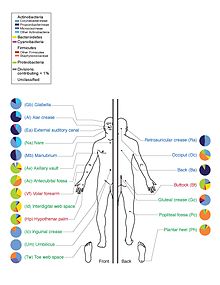- Microbiome
-
A microbiome is the totality of microbes, their genetic elements (genomes), and environmental interactions in a defined environment. A defined environment could, for example, be the gut of a human being or a soil sample. Thus, microbiome usually includes microbiota and their complete genetic elements. The human microbiome contains over 10 times more microbes than genetically human cells.[1]
The expression "microbiome" was coined by Joshua Lederberg. In his opinion, the microorganisms should be included as part of the human genome, because of their influence on human physiology.
An enterotype is a classification of living organisms based on its bacteriological ecosystem in the human gut microbiome. Three human enterotypes have been discovered.[2][3]
Notes
- ^ Zimmer, Carl (13 July 2010). "How Microbes Defend and Define Us". New York Times. http://www.nytimes.com/2010/07/13/science/13micro.html?_r=2&pagewanted=all. Retrieved 17 July 2010.
- ^ Zimmer, Carl (April 20, 2011). "Bacteria Divide People Into 3 Types, Scientists Say". The New York Times. http://www.nytimes.com/2011/04/21/science/21gut.html. Retrieved April 21, 2011. "a group of scientists now report just three distinct ecosystems in the guts of people they have studied."
- ^ Arumugam, Manimozhiyan; et al (March 2010). "Enterotypes of the human gut microbiome". Nature 473 (7346): 174–80. doi:10.1038/nature09944. PMID 21508958. http://www.nature.com/nature/journal/vaop/ncurrent/full/nature09944.html. "Our knowledge of species and functional composition of the human gut microbiome is rapidly increasing, but it is still based on very few cohorts and little is known about variation across the world. By combining 22 newly sequenced faecal metagenomes of individuals from four countries with previously published data sets, here we identify three robust clusters (referred to as enterotypes hereafter) that are not nation or continent specific."
See also
External links
Categories:- Microbiology
- Microbiology stubs
Wikimedia Foundation. 2010.

